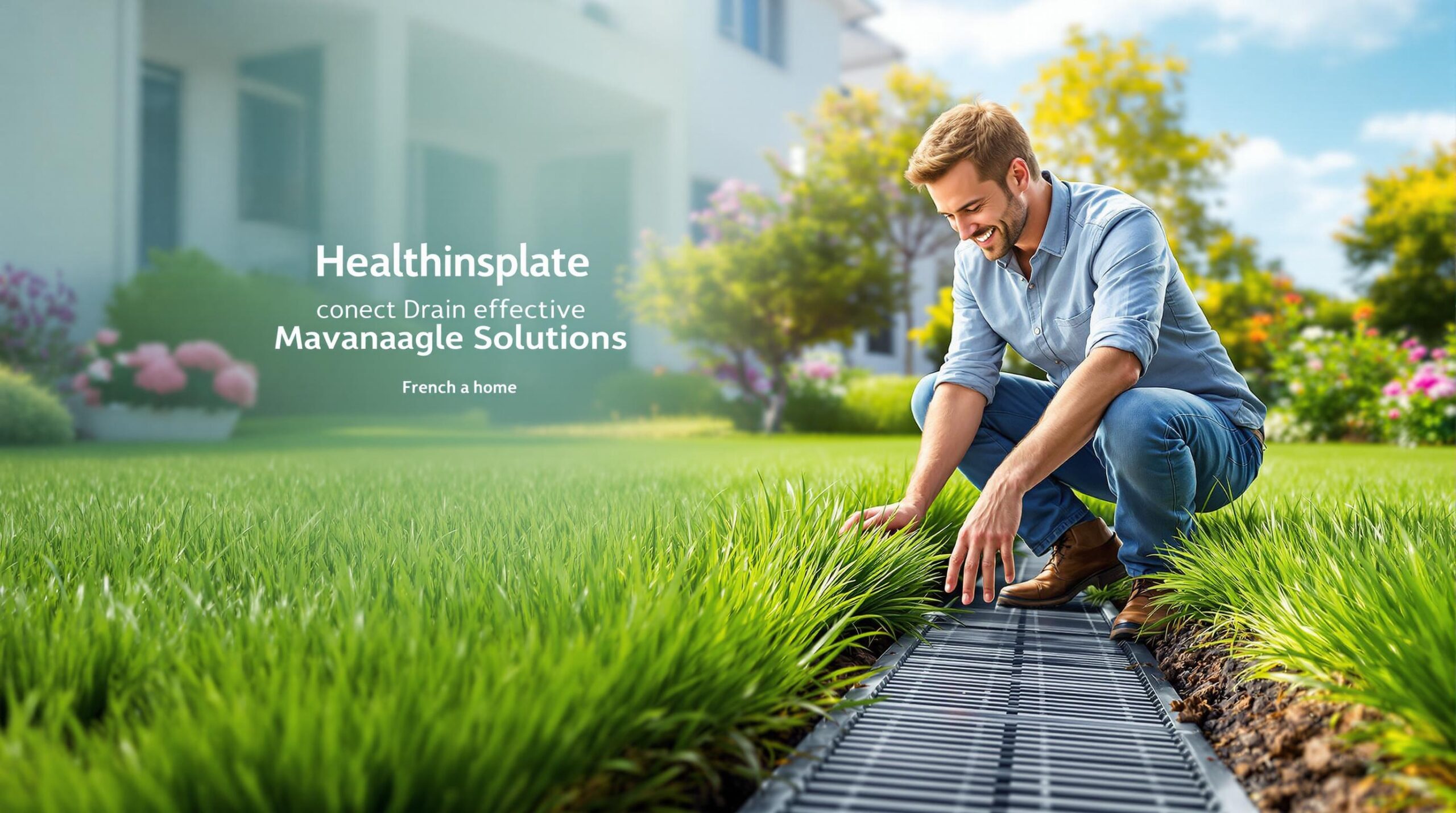- bhavya gada
- No Comments
Dealing with drainage problems? Here’s what you need to know:
Poor drainage can damage your home’s foundation, flood basements, ruin landscaping, and create safety hazards. The good news? You can fix these issues with simple solutions like grading your yard, installing French drains, or using permeable paving.
Key Solutions at a Glance:
- Yard Grading: Ensure a 2–5% slope away from your home.
- French Drains: Redirect water underground using gravel and perforated pipes.
- Rain Gardens: Beautify your yard while managing runoff.
- Permeable Paving: Reduce water pooling with materials like gravel or permeable pavers.
Signs of Drainage Problems:
- Standing water after rain.
- Cracks or stains on your foundation.
- Damp basements or musty smells.
- Washed-out soil or struggling plants.
Tip: Maryland homeowners face extra challenges due to clay-heavy soil and frequent rain. Regular inspections and seasonal maintenance are essential to keep your drainage system in top shape.
Ready to protect your home? Start by inspecting your yard and tackling drainage issues before they escalate.
Finding Drainage Problems
Signs to Watch For
Water drainage problems often show themselves through obvious signs. For example, standing water after a rainstorm is a strong clue that water isn’t draining as it should. Keep an eye out for these specific issues:
- Soggy Ground: Patches of soil that stay wet and squishy long after the rain has stopped.
- Foundation Concerns: Stains or cracks around the foundation that suggest water buildup.
- Basement Problems: Damp walls or a musty smell, which could mean water is seeping in.
- Landscape Damage: Washed-out soil or mulch scattered across sidewalks or paths.
- Unhealthy Plants: Plants struggling or dying in areas that are consistently wet.
Spotting these signs means it’s time to take a closer look at your yard.
How to Inspect Your Yard
Once you notice potential issues, here’s how to check your yard for drainage problems:
-
Observe During Rain
Watch your yard during rainfall to identify areas where water collects or flows poorly. -
Check Gutters and Downspouts
Look for overflowing gutters or water pooling near the base of downspouts. These could indicate blockages or improper drainage. -
Test the Soil
If your yard has heavy clay soil, common in areas like Maryland, test how well the soil absorbs water. Slow absorption might mean the soil is compacted and causing drainage issues.
When to Call a Professional
If your inspection uncovers serious problems, it’s time to bring in an expert. You should consider professional help if you notice:
- Large cracks in your foundation.
- Persistent moisture or flooding in your basement.
- Multiple drainage problems happening at once.
Professionals are essential for tackling complex drainage issues. They can handle tasks like working around underground utility lines, ensuring compliance with building codes, calculating slopes accurately, and determining the best drainage points. For major projects, expert help can save you from costly mistakes and ensure everything is done correctly.
How to Install a French Drain that Actually Works! DIY Project
sbb-itb-843f8be
4 Key Drainage Fixes
Once you’ve spotted drainage problems, you can tackle them with these effective solutions to protect your property.
Yard Grading Basics
The first step is to reshape your yard’s foundation. To ensure proper drainage, aim for a slope of 2–5% (about a 1/4-inch drop per foot). Here’s how to grade your yard:
- Use a level and string to measure the current slope
- Add soil near the foundation as needed
- Create a smooth, consistent grade
- Apply topsoil and plant ground cover to prevent erosion
French Drain Setup
A French drain is a simple underground system that channels excess water away, perfect for dealing with standing water or basement dampness.
To install one, dig a trench along the natural flow of water with a slight downward slope leading away from your home. Make the trench 12 inches wide and 18 inches deep. Line it with landscape fabric, place a perforated pipe (holes facing down), backfill with gravel, and cover it with soil.
Building Rain Gardens
Rain gardens are a visually appealing way to manage water runoff while improving your yard. They also support local ecosystems by using native plants. To build one:
- Place it at least 10 feet from your home’s foundation
- Use an existing low spot in your yard or create one
- Add a soil mix that drains well
- Plant moisture-tolerant native species that handle both wet and dry conditions
Water-Friendly Paving Options
Using permeable paving materials helps water soak into the ground rather than causing runoff, which can reduce drainage problems around paved areas.
| Paving Type | Benefits | Best Used For |
|---|---|---|
| Permeable Pavers | Durable and visually appealing | Driveways, patios |
| Gravel | Affordable with excellent drainage | Walkways, parking areas |
| Pervious Concrete | Long-lasting and reduces runoff | Large paved areas |
Mix and match these strategies to create a complete drainage solution that works for your property.
Upkeep and Care
Keeping your drainage system in good shape is essential to protect your home. Routine maintenance and preparation for seasonal changes will ensure water flows smoothly year-round.
Regular Check-ups
Set up a maintenance routine with these key tasks to keep your drainage system in top condition:
| Timing | Task | Purpose |
|---|---|---|
| Monthly | Inspect gutters and downspouts | Avoid clogs and overflows |
| Quarterly | Clean drains and remove debris | Keep water flowing properly |
| Bi-annually | Check system components | Spot and address issues early |
| Annually | Get a professional inspection | Ensure everything works well |
Regularly remove debris from gutters, French drain outlets, catch basins, channel drains, and pop-up emitters to keep water moving efficiently.
"Good landscape design takes into account where water flows on a property, and how to redirect that water so that plants get just the right amount of water and homes stay dry." – Johnson’s Landscaping Service
Maryland Weather Prep
Maryland’s varied climate means your drainage system needs specific care for each season. Here’s what to do:
Winter Preparation
- Clear all gutters before freezing weather hits.
- Add inline outlets for downspouts connected to buried pipes.
- Create air gaps in sump pump discharge lines.
- Drill 1/4-inch weepholes in sump basins to prevent freezing issues.
Spring and Summer Care
- Remove debris that built up over winter.
- Check for any winter damage to drainage parts.
- Confirm downspout aprons direct water away from your foundation.
- Clear weepholes in pop-up emitter elbows.
Fall Maintenance
- Regularly remove fallen leaves.
- Inspect all discharge points for blockages.
- Clear surface drains of leaves and debris.
- Check and clean the interiors of channel drains.
Frozen ground during winter can lead to ice on walkways and potential water damage as it thaws. Sticking to a consistent maintenance routine helps avoid these problems and keeps your drainage system running smoothly.
Next Steps
After your initial inspection, it’s time to focus on identifying and prioritizing necessary repairs.
Start with a drainage test. Dig a 2-foot hole, fill it with water, and monitor how long it takes to drain. If water remains for more than 12 hours, you likely have drainage problems. Also, check if the ground slopes away from your home at a minimum of 3% (about 3 inches per 8 feet).
| Step | Warning Signs | Action Needed |
|---|---|---|
| Drainage Test | Water remains >12 hours | Install a French drain |
| Grade Check | Slope less than 3% | Regrade sections of the yard |
| Foundation Check | Water near foundation | Install a drainage system |
| Soil Test | Heavy clay or compacted | Add organic material, aerate soil |
Once you’ve gathered your findings, create a property map to identify:
- Existing drains and pipes
- Areas prone to standing water
- Natural water flow paths
- Locations of underground utilities
Set up a seasonal maintenance routine to ensure your drainage system stays effective. Good drainage safeguards your foundation, prevents soil erosion, and keeps your landscaping in good shape. If you’re dealing with complex or multiple issues, it might be worth consulting a professional to find the best solutions for your property.


















Chat with Us